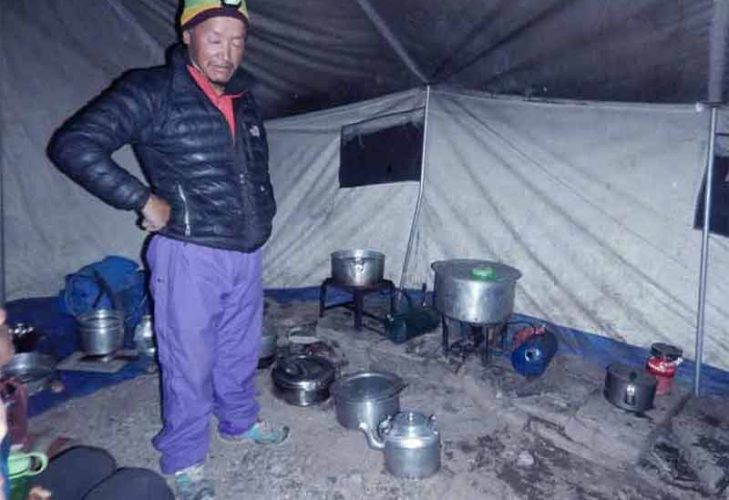DETAILS ITINERARY FROM LUKLA TO ISLAND PEAK

DETAILS ITINERARY FROM LUKLA TO ISLAND PEAK CLIMBING
Island Peak, also known as Imja Tse, stands at 6,189 meters (20,305 feet). While it is technically less challenging than some of the other peaks in the region, it still requires basic mountaineering skills and the ability to navigate glacial terrain. The climb includes some steep sections and a final ridge that leads to the summit. Using ropes and crampons is common on this route.
Climbing Tsland Peak from Lukla is an adventurous journey that requires proper planning and preparation. Here’s a detailed itinerary for the Lukla to Tsland Peak climbing expedition:
Day 1: Arrival in Lukla (2,800 meters) (2610 Meters) Phakding
Fly from Kathmandu to Lukla, which is the starting point of your trek. Trek from Lukla to Phakding, a small village situated along the Dudh Koshi River. The trail offers beautiful views of the surrounding landscapes and takes approximately 3-4 hours.
Day 2: Phakding to Namche Bazaar (3,440 meters)
Continue your trek to Namche Bazaar, a bustling Sherpa town and the gateway to the Everest region. The trail involves crossing several suspension bridges and ascending steeply. Trekking time is approximately 6-7 hours.
Day 3: Trek Depart from Namche to Khumjung (3790 Meters)
Start your trek to Khumjung for 2-3 hours, making sure you have all the necessary supplies and are adequately acclimatized to the altitude. Head east: From Khumjung, follow the trail heading east. The path will descend initially, leading you through the beautiful landscape of the region.
Day 4: Khumjung to Pangboche
Arrive at Pangboche from Khumjung: After 5-6- hours of trekking, you’ll finally reach Pangboche. This village is located at an altitude of around 3,930 meters (12,890 feet) and is known for its ancient monastery, Pangboche Gompa, which is one of the oldest in the region.
Day 5: Pangboche to Amadablam Base camp visit Pangboche
Reach Ama Dablam Base Camp: After several hours of trekking, you’ll finally arrive at Ama Dablam Base Camp, situated at an elevation of approximately 4,570 meters (14,993 feet). Take in the awe-inspiring views of Ama Dablam’s majestic peak and the surrounding glaciers.
Day 6: Pangboche to Chhukung-5-hrs
Arrive at Chhukung: Chhukung is a small village situated at an altitude of about 4,730 meters (15,518 feet). It serves as a base for various trekking routes, including Island Peak. Enjoy the mesmerizing mountain views and prepare for further exploration or climbing endeavors if you’re planning to undertake them.
Day 7: Chhukung Ri Climbing (5550 Meters) Trek back to Chhukung
Summit Chhukung Ri: The summit of Chhukung Ri stands at an elevation of approximately 5,550 meters (18,208 feet). Enjoy the breathtaking views from the top, including the towering peaks of the Everest region.
Day 8: Chhukung to Island Peak High Camp (5,400 meters)
Ascend to the High Camp of Island Peak. The trail becomes steeper and more challenging as you gain altitude. The day’s trek takes around 5-6 hours. Rest and prepare for the summit push.
Day 9: Summit Day (6,189 meters) and descend to Base Camp
Start early in the morning for the summit push. The climb involves traversing glaciers, using crampons, and ascending steep sections. Reach the summit of Island Peak and savor the breathtaking views. Descend back to Base Camp.
Day 10: Island Peak base camp to Chhukung
Today your trek returns back to Chhukung village and you must return back the climbing equipment that you hire from Chhukung.
Day 11: Island Chhukung to Tengboche (3,860 meters)
Trek to Tengboche, retracing your steps through Dingboche. Enjoy the scenic descent and the familiar trails. Trekking time is approximately 5-6 hours.
Day 12: Tengboche to Namche Bazaar
Continue descending from Tengboche to Namche Bazaar, passing through lush forests and charming villages. Trekking time is around 5-6 hours.
Day 13: Namche Bazaar to Lukla
The final leg of the trek, trekking from Namche Bazaar back to Lukla. Celebrate the completion of your journey with your team. Trekking time is approximately 6-7 hours.
The best time to do Island peak climbing. is during the Spring ( March to June) and autumn (September to November) seasons. These months offer the most favorable weather and optimal conditions in the Everest region. Spring (March to June): This is the post-winter season when the weather starts to warm up, and the trekking trails become vibrant with blooming flowers and rhododendrons. The temperature is generally mild, with clear skies and excellent visibility. It’s a great time to witness the beautiful landscapes, lush greenery, and panoramic mountain views.
Autumn (September to November): This is the post-monsoon season when the weather is stable, and the skies are generally clear. The temperature is comfortable, making it ideal for trekking and climbing. The autumn months offer breathtaking views of the mountains, including the Everest ranges, and the overall trekking experience is enhanced by the festive atmosphere during the Nepalese Dashain and Tihar festivals.
Island Peak climbing, is the choice that ultimately depends on your preferences. If you enjoy seeing colorful flowers and blooming vegetation, spring is a good choice. If you prefer clearer skies and panoramic mountain views, autumn is a great option. It’s worth noting that the Everest region can be visited year-round, but other seasons such as winter (December to Feb) and monsoon (July to August) may bring more challenges due to cold temperatures, snowfall, and potential landslides.
